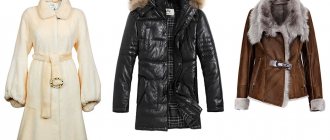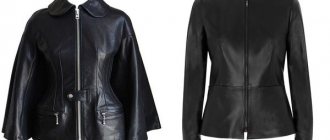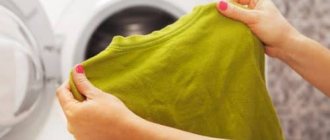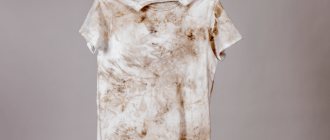Quote from ADELERA
Read in full In your quotation book or community!
Do you want to know how to wash denim clothes, how to care for jeans so that they will delight you with their newness for quite a long time? Read below) And you will also find out what the symbols on clothing labels mean
Recommendations for washing denim clothing
- It is better to fasten the zipper on your jeans before washing.
- Denim clothing should only be washed inside out.
- Do not use powders containing bleach.
- When soaking and washing, washing powder must be diluted in water, and not sprinkled on denim clothes.
- It is advisable to wash denim clothes separately from other items.
- Wash in warm water, preferably by hand
- It should be dried without twisting or squeezing, but after hanging, let the water drain.
And in the 80s... Jeans were washed on oneself, without taking them off, with cool water and laundry soap.
And they dried it, again, without taking it off, so that the jeans would fit their figure. Denim clothing that has a special double overdye dyeing, which gives it a deep, rich color, can be dyed before the first wash.
Jeans can be ironed, preferably on the wrong side!
Washing fur products in an automatic machine
There are several methods for washing faux fur. Of course, the easiest way to clean items made from artificial material is machine washing. However, this technique is only suitable for a certain category of products. Only items with short, dense pile attached to a high-quality base can be loaded into the machine. For best results it is recommended:
- soak the product;
- choose a suitable remedy;
- select the correct mode;
- provide the necessary conditions for drying.
Before washing faux fur in an automatic machine, soak it briefly in warm, soapy water. Too hot water can cause damage to the item of clothing, and prolonged exposure can cause the fur to fall out of the base. For machine care, you should choose special products designed for washing fur products. Typically they come in liquid form. The usual powder can remain between the fibers and ruin the appearance of the clothes. To remove intense stains, you can use laundry soap.
Faux fur clothing should be washed separately from any other items. Suitable automatic modes include “delicate”, “hand wash”, “lingerie”. The machine should be set to the minimum number of revolutions and without spinning. Rinsing should be done manually, in cool water without adding conditioner. To add shine to the product, you can add a little lemon juice or vinegar to the water. It is not recommended to wring out any fur products. Such clothes easily lose their shape and fluffy structure. It is better to dry the product on a horizontal surface in a well-ventilated area. It is allowed to place the item of clothing on a hanger.
Important! The main aspects of caring for clothing made from artificial material are written on the factory label. If this is not available, then machine washing should be abandoned.
Handwash
In many situations, the best way to clean the edges on a down jacket is hand washing - especially when the fur is natural. If the collar is detachable, then you are in luck; it will be much more convenient to work with.
- If the contamination is not too serious, then you can wash the collar in running water using regular hair shampoo. For greater effectiveness, you can add a little detergent to it. The easiest way to dry such fur is by carefully wrapping it in a dry fluffy towel.
- If the contamination is strong enough, then before washing it is recommended to pre-apply a mixture of two teaspoons of salt with a spoonful of ammonia dissolved in a glass of water to the fur. Then let the collar sit for a while and wash it as usual.
Tip: The best way to wash a fur collar from a down jacket with faux fur is to use a warm powder solution that is designed for washing wool and/or silk. Soak the edge in this solution, leave for about twenty minutes, then rinse with regular running water.
Not all types of fur can be washed. For example, it is strongly not recommended to wash the Arctic fox; only dry cleaning is suitable for them. In addition, it is recommended not to overuse washing, even gentle washing, if your product is made of natural fur.
The fact is that during washing, the fatty components of fur dissolve, which make it shiny and elastic. And if a few rare washes are tolerated well, then over time the condition of the edge of the down jacket will become more and more sad. If the stain is too severe for dry cleaning, be sure to contact a dry cleaner.
— Albert Vasilievich, dry cleaning worker
Related articles: Are there stains on your down jacket after washing? .
The nuances of washing faux fur clothes
Most products made from this beautiful synthetic material require special attention. Sometimes it is particularly difficult to maintain the cleanliness of a combined product. The combination of several types of fabric can cause the color of the fur insert to change.
How to wash clothes with fur on the hood
Fluffy trim adorns knitted cardigans, padded jackets and practical parkas. The process of washing fashion items is greatly simplified by detachable faux fur. It is also very clear to care for a hood with a zipper or buttons. There are the following options for washing a product with a fur hood:
The hood with fur, detachable from the jacket, is washed separately. To do this, it is placed in a special bag for delicate washing and placed in a washing machine with liquid detergent for synthetic fabrics. The water temperature should be no more than 30 degrees. When finished, the fur should be dried thoroughly and then combed with a regular brush.
It is better to freshen delicate fur by hand. The detachable hood is placed in warm water with laundry soap. The fabric itself can be gently rubbed with a brush, and the insert can be rinsed in a soapy solution. Next, the product must be dried and combed.
The most labor-intensive option is a product with a one-piece cut. You can wash such an item in automatic mode only at your own peril and risk. The best solution is to soak the item of clothing in warm water with laundry soap or gel. It is advisable to avoid immersing the fur in the basin. Next, the fabric must be rubbed with a brush or by hand, rinsed carefully, and squeezed out everything except the fur.
Note! It is forbidden to dry fur products over a radiator or stove. Exposure to dry air leads to a deterioration in the aesthetic qualities of clothing and can lead to shrinkage of the item. If the fur becomes electrified after drying, it should be treated with an antistatic agent or conditioner spray.
How to bring the purity back to a denim jacket with faux fur
A denim jacket, insulated with synthetic fur or decorated with a fur collar, is a must-have in the wardrobe of any fashionista. A stylish denim item is quite problematic to care for. Saturated dark fabric is prone to washing off paint, which, in turn, settles on light-colored collars. In addition, thick denim is washed only at high speeds and high temperatures, which is unacceptable for synthetic material. How to wash jeans with a faux fur lining or collar:
- conduct a color fastness test;
- For intense stains, soak for a short time;
- wash in machine or by hand;
- do not squeeze;
- dry carefully.
When new jeans are washed for the first time, they turn the water a rich blue color. This is especially true for budget clothing. To prevent the dye from ruining the synthetic fur lining, it is worth checking the dye fastness in advance. To do this, you can soak the sleeve of the product in warm water for 15-30 minutes. If the water becomes colored, then the item should be washed exclusively in cold water and as quickly as possible. It is recommended to add a color enhancer.
It is better to first lubricate pronounced stains on the jacket or lining with laundry soap and soak for 30-60 minutes (provided that the item does not fade). After this, the clothes should be placed in the machine with a gentle liquid product. For short and dense fur, you can use regular washing powder. It is strictly forbidden to choose modes with spin or intensive cleansing. It is quite possible to wash the item by hand. To make cleaning thick denim easier, use a soft brush. It is necessary to rinse in cool water; adding conditioner is allowed. The jacket must be dried on a horizontal surface or hanger. Clothespins may leave creases on the product.
Cleaning fur on boots
If dirt has formed on your boots, then you should definitely use practical tips on how to clean faux fur on shoes. To do this, you need to use products that will remove dirt without changing the color of the product. An effective remedy is baking soda, which is rubbed into contaminated areas with your hands until it changes color to gray. Thanks to this product, you can quickly and effectively deal with dust and dried dirt. Remaining soda can be removed by shaking the boots several times.
In addition to soda, you can also use flour, talc or potato starch, which are also rubbed into the fur edge of the boots, and then shake them thoroughly.
Features of hand washing clothes with synthetic fur
The best solution would be to hand wash items with faux fur inserts. This will allow you to track the process at all stages and clean the fur product as carefully as possible. To wash synthetic fur by hand you need to:
- pre-soak the item;
- gently rub the fabric;
- rinse the fur insert;
- let the water drain;
- dry carefully.
If you only need to refresh clothes and not remove dirt, then soaking can be neglected. For intense stains or persistent unpleasant odors, synthetic clothing can be soaked for 15-30 minutes with the addition of a mild detergent. Contaminated areas should be rubbed with soap or soap with bile. It is allowed to use gentle stain removers designed for washing faux fur items. It is not recommended to subject the material itself to friction. Areas made from other fabrics can be lightly rubbed.
Clothes should be rinsed in warm or cool water, adding a little conditioner, vinegar or lemon juice for elasticity and shine. Then carefully lay out the product, without stretching it, and allow excess moisture to drain. Clothes should not be wrung out; they should be dried horizontally or hanging, avoiding clothespins and other squeezing devices. After complete drying, comb the hand-washed fur with a wide-tooth comb and treat it with an antistatic agent.
Adding shine
To give a fur product a beautiful shine, you can use a weak solution of acetic acid, glycerin or lemon juice. You need to thoroughly treat the fur with one of these products, and then wipe it with a napkin.
In addition, a special product made from fish oil (100 g), ammonia (12 drops), ordinary laundry soap (10 g) and boiling water (1 l) will help to add shine to a fur product. All these components must be thoroughly mixed, then the resulting solution must be cooled to a temperature of 35 degrees and the fur must be thoroughly treated with it. If the fur coat is dusty, then you need to wrap it in a damp sheet and then knock it out.
We suggest you familiarize yourself with Washing a shirt by hand
Dry cleaning of synthetic fur clothing
High-quality professional cleaning of products made from artificial materials is carried out in dry cleaners. However, even at home you can return the product to its former freshness and cleanliness. For white clothes, starch is best. The powder is diluted with a small amount of water to obtain a kind of slurry. Then the resulting composition is applied to the fur and left until completely dry. The hardened mass is carefully removed with a soft bristle brush. There are other methods of dry cleansing, for example:
- using lemon juice or acid;
- elimination of impurities using bran;
- using dishwashing detergent;
- using baking soda.
Lemon juice is a reliable ally in the fight for the whiteness of synthetic materials. It is applied to the fur from base to tip using a small sponge. After drying, the product is combed. The technique removes unpleasant odors from the product and returns shine and softness to clothes. This method is not suitable for caring for items of saturated colors. In the absence of lemon juice, ordinary citric acid diluted with water will do.
Bran is traditionally used for fur of any color. You should first pass them through a meat grinder or grind them in a coffee grinder. Once a flour-like consistency is achieved, the bran is applied to the pile and left for several hours. After the specified time, the product is thoroughly combed with a comb or brush. Bran absorbs foreign odors and softens the villi.
In special cases, when heavily soiled, it is recommended to apply a small amount of undiluted dishwashing detergent to the clothes. Leave the liquid for 15-30 minutes, then carefully wipe off with a damp cloth. For light-colored items, adding baking soda will help speed up stain removal. It can also be used separately, applying it to the item for half an hour, and then combing the villi.
Video material
Now you know all the features of cleaning clothes made from faux and natural fur, so you can safely do it yourself at home, rather than spending money on dry cleaning. Take care of your things, clean them on time and they will serve you for a long time, which means you will always look stylish and beautiful!
How to wash a faux fur coat in a washing machine
Such a large and heavy product is, of course, difficult to wash by hand. However, machine washing can damage the item by ruining the fur or changing its shape. Whether a faux fur coat can be washed should be checked on the label of the item of clothing. If the manufacturer does not prohibit such care, the following nuances should be taken into account:
- You should use only warm water;
- The product should be washed as rarely as possible;
- It is prohibited to use “aggressive” modes;
- It is better not to use washing powder;
- the product cannot be wrung out;
- The item should be dried away from heating appliances.
Before washing a faux fur coat, you should fill a container with warm water with the addition of soap shavings or gel for gentle cleansing. If necessary, pre-soaking of the product is allowed. It is strictly forbidden to wash a fur coat in hot water - this will cause the lining to shrink and cause the fur to fall out and become fluffy. Do not resort to a full wash even with minor stains. You can restore the freshness of your fur coat and clean a couple of stains using dry methods. Only in exceptional cases should you load the product into an automatic machine.
For washing, delicate modes that do not involve spinning are best suited. If the device allows, then it is worth reducing the number of revolutions and setting the lowest water temperature. For best results, gel or liquid laundry detergents designed for synthetic clothing are recommended. If none of the above is present, then you can use regular hair shampoo. In this case, the dirt is pre-treated with a stain remover or dishwashing detergent.
As with other faux fur products, the immutable rule for synthetic fur coats is drying under natural ventilation without exposure to heating devices. Clothes are not hung on clothespins or folded on lines. Bends on artificial material are almost impossible to correct after the item has completely dried. After cleansing, the fur coat is combed and sprayed with conditioner.
Denim clothing has long taken its place on the fashion pedestal and is clearly not going to leave it. For several centuries, men and women have been wearing comfortable denim outfits, which can be combined with different shoes and outerwear. Jeans are suitable for many occasions as they embody a classic, casual or street style.
Denim is very unpretentious, but there are recommendations on how to wash jeans in a washing machine so that they look like new for a long time.
How to wash jeans so they don't stretch
In order for jeans to retain their presentable appearance, original shape and color longer, you need to wash the products separately from other items at temperatures up to 40 degrees. Before each wash, be sure to turn your jeans inside out, fasten the zipper and buttons!
Experts recommend washing by hand, but you can also wash it in a washing machine on a delicate cycle without spinning. For washing, use warm water, a mild detergent without bleaching ingredients, or a soap solution made from laundry soap. To speed up washing and effectively remove stains and dirt, add a glass of table salt to the water when washing by hand.
Do not soak, wring out or twist denim too much. To dry, do not throw the material over a rope, otherwise streaks and marks will remain. In addition, after drying, such a thing is difficult to straighten and smooth. Jeans should be dried, just like washed, inside out. To dry, attach the items to a rope on your belt.
If necessary, you can iron completely dried trousers from the wrong side with a warm iron. Do not wash your jeans too often, otherwise the structure of the material will quickly deteriorate and they will lose their original attractive appearance. To prevent this from happening, it is recommended to wash it no more than once every five wears.
If the donated jeans turned out to be too big, or your favorite ones began to hang loose, this is not a reason to be upset. In most cases, you can reduce jeans by one or even two sizes yourself, without resorting to the services of a tailor.
There are two main ways to solve the problem:
The choice of method depends on the type of fabric, model of trousers and how much you want to reduce them. If the pants are a little too big, you can get by with a simple shrinking procedure, but this method is not suitable for all types of jeans. Large differences in size can only be corrected using a sewing machine.
Features of washing denim products
Jeans clothes can be washed by hand, machine washed, or dry cleaned. The choice of method depends on the characteristics of the item itself and the type of contamination.
What you should pay attention to:
- The density of matter, its elasticity.
- Sewn or glued decorations.
- Decorative abrasions (fading).
There are different types of denim (for example, raw or stretch). Density and composition are the main indicators that change the appearance and properties of the finished item. Caring for thin, post-processed denim differs from caring for classic, virgin, untreated, very thick denim.
The presence of embroidery, rhinestones, sequins, beads and other decorations also affects cleaning methods. To keep all elements in place and safe, you need to be careful when handling.
Clothes with designer rips and rips are a popular trend. But the beauty of such clothes lies precisely in the neatness of the torn elements. A careless attitude will lead to unsightly tears and hanging threads, which will cause the item to lose its intended chic and take on the appearance of worn-out clothing.
Is it possible to wash jeans often?
Jeans were invented centuries ago. It was a coarse cotton fabric, similar to canvas. Its peculiarity was the twill weave of threads of two colors: white and indigo. Clothes for workers, cowboys, gold miners, and sailors were made from this fabric, since it was highly durable and protected from bad weather. An important quality was considered to be that denim trousers did not require frequent washing, despite their daily wear.
Preparing clothes
Still, you need to monitor the cleanliness of your jeans, but do it correctly. If you handle it carelessly, you risk losing your favorite item.
The fabric has its drawbacks in handling:
- prone to shrinkage, stretching, deformation;
- the most durable dye can fade;
- may become rough;
- Extra creases and unnecessary wear often appear.
As it turned out, jeans are quite capricious and require delicate care, despite the apparent roughness.
The very first stage is preparation.
- Fasten all rivets, buttons, zippers. An unzipped zipper may tear the fabric.
- Check that all fasteners are securely sewn. Heavy button bolts that do not adhere well can come off, tearing out a fair amount of flap.
- Check all the pockets, because many people like to carry money, chewing gum, and small change in their jeans.
- Turn the item inside out to preserve the decor.
- Place thin denim trousers with small details in a mesh bag.
- Consider the features of the inserts (for example, leather, fur, guipure).
New, unworn jeans have their own rules.
- To avoid staining, wash separately from other clothes the first time.
- Choose hand wash.
- To fix the dye, add a little vinegar to the water.
Selecting the desired mode
To care for jeans, hand washing or dry cleaning is recommended. But few people are willing to spend effort on washing, rinsing, and hand-wringing heavy fabric. And few people will agree to take their clothes to the dry cleaner every time when there is an assistant - a washing machine that will cope with the task much faster. Use the right mode and your denim trousers or jacket will be like new for a long time.
Choose the right program. The “cotton” mode that we use for bed linen is inappropriate here. Choose a mode for washing jeans. If it is missing, any delicate programs will do. What to pay attention to:
- duration (a lightly soiled item should not be washed for a long time);
- the amount of water the machine uses (the more water in the drum, the more accurate the wash);
- the number of washing and spinning revolutions should not be high, 600–800 is enough;
- water temperature.
Unreal life hacks
Caring for jeans is easy. Knowing some of the right tips and tricks can extend the life of jackets, shorts, shirts and other clothing made from this fabric.
Let's look at some little-known life hacks:
- instead of washing - freezing;
- We grow ourselves - we stretch our jeans. If you have gained weight, you can increase your trouser size a little. To do this, you need to wet them and put more objects into the belt that will stretch them;
- You can reduce the size by lying in a hot bath until the water cools completely. This method will help the matter shrink;
- to fix a zipper that is stuck, use stylus, wax or lubricants such as oil, chapstick;
- The zipper opens - attach the ring to the tongue and connect it to the button.
We suggest you familiarize yourself with How to choose a bedding set (CPB)
What about storing such clothes? It is recommended to keep it folded in a closed cabinet. If you plan not to use clothes for a long time, you can place them in a special bag - this way they will not become saturated with odors and will not accumulate dust.
Suitable detergents
The correct regime is not the final guarantee of success. Fabric washing agents play an important role. For good cleaning, you need compounds that dissolve well in cool water and penetrate the fibers without destroying their structure.
Therefore, the use of powder will be undesirable. The granules will not melt completely, the effect of the soap composition will be small, and in order to rinse thick fabric well, you will have to try.
Liquid products, for example, capsules and special gels, which have a gentle effect, are much more economical and effective.
During the final rinse, you can use fabric softener to soften the fabric.
Do not use chlorine containing products, even on white jeans, as it will corrode the thread.
Detergent
Can faux fur be washed? Can. Such a product can be processed manually, cleaned using home or professional products.
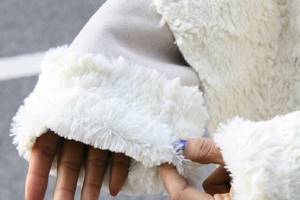
It is better to use specially formulated chemical products designed to remove dirt from artificial pile.
Manufacturers of such products recommend using the following products:
- FLAT;
- VESTAR (washing gel);
- Emsal Tuba;
- Alles Gut;
- Dreft Delicates{amp}amp;Color;
- Luxus Professional;
- Frosch.
All detergents will provide a delicate wash, show good results, retain the shape of the product and protect the color from fading.
We suggest you read: How to clean a dishwasher from grease and scale?
Proper stain removal
Jeans are quite difficult to get dirty. But once a stain appears, removing it can be a problem. If dirt has penetrated deeply into the dense fibers of the fabric, it will be necessary to remove particularly difficult stains before washing.
The easiest option is to use stain removers. There are special products for specific stains. But if you don't have a stain remover, use other products.
An important rule for using any product when removing stains: test it on an inconspicuous area to avoid color washing out and damage to the fabric at the treatment site. So, how to remove different types of stains:
- Fatty and oily substances are washed off with kerosene, white spirit, acetone, and purified gasoline. Dishwashing detergent will also work. Soak a cotton swab or piece of scrap fabric in solvent and gently rub the stain.
- Dye. First, let it dry thoroughly, since a damp stain is almost impossible to remove. Using a sharp object, carefully clean off the dried stain, moving from the edge to the center, and then use a solvent.
- Ink from a ballpoint or gel pen. Soak the stain with an alcohol solution, then rub in regular salt.
- Chewing gum. Put your jeans in the freezer and take them out onto the balcony in winter. The frozen toffee will completely come away from the fabric, down to the smallest particles.
- Grass. A small amount of hydrogen peroxide will not leave a trace of green juice.
Depending on the complexity of the contamination, the item is left for some time with the product applied. Regular dirt comes off well after soaking in water with dissolved powder.
After removing the stain, a long machine wash in warm water is required.
Rules for light things
You've probably already thought about how to wash white clothes - separately and using bleach. But as for white down jackets, there are some recommendations here. More details about them later and in the video in this article.
Always turn your white jacket inside out. Take everything out of your pockets first.
Unfasten the hood if fur is attached to it.
Treat your winter jacket with a treatment that repels water.
Use only liquid laundry detergents. Aggressive powders will wash away the impregnation, and the fluff may turn yellow.
Add conditioners to quickly restore the down jacket.
If necessary, buy a water softener if the liquid powder does not contain it.
You need to wash your down jacket at the temperature stated on the tag.
This way, you can protect the fabric from the aggressive effects of water and powder, and keep the whiteness and filler in their original form.
Try to follow all recommendations and advice. Washing a fur trim sewn to the hood or cuffs of a jacket without ripping it off is a completely doable task.
We'll tell you how to do this. Everyone knows that the first thing that gets dirty in our warm clothes is the fur trim on the hood and sleeves. Especially if it is light. The thing immediately takes on an unkempt and dirty appearance. But what to do if the fur trim is not removable (cannot be unfastened). In principle, it is not recommended to wash an item (coat or jacket) to which the edge is sewn. The label clearly states - no washing!
Of course, we will not violate the rules indicated on the label, well, not really...
We will try to wash not the entire jacket, but only the fur (edge) on the hood or cuffs.
Of course there is some element of risk. For example, if the fabric or fur sheds, but most likely during wear you would have already noticed it.
If our jacket or down jacket is made of raincoat, bolognese or other synthetic fabric, then our washing method is unlikely to harm it.
And now everything is in order.
First you need to prepare a solution for washing our fur (edge).
For this purpose, powder or gel for delicate washing or ordinary hair shampoo is suitable.
Dilute a small amount of shampoo - 1 cap in a small volume of warm water. Whip the foam carefully - the more, the better.
Then, carefully lower our fur (edge) into the foam. Try to ensure that only fur gets into the water with foam.
But even if a small part of your jacket or coat gets wet, nothing bad will happen.
Carefully wring out all the fur and hang your item so that the fur is at the bottom.
Because the water is actively draining.
It is advisable to place a basin or other container for water under the drops.
Water absorbed into the fur should not flow onto the jacket or coat, but into a basin or bathtub. Therefore, the main thing is to make sure that the wet fur is located below our item
The fur will gradually drain and dry.
To do this, you can use a regular comb-brush.
And now your jacket, coat, down jacket or parka looks like new.
The advantages of our washing method are obvious:
- We don't need to strip fur from a jacket or coat.
- There is no need to use dry cleaning services.
- We do not wash the entire item. We only wash the fur from the hood and on the cuffs.
- No problem, you can wash faux, synthetic or natural fur.
- We do all our laundry at home.
But whether our method of solving the problem is right for you is up to you to decide.
We will not say that the easiest way is to clean a fur collar in a special salon, since this pleasure is not cheap, but we will give recommendations on how to wash a fur collar at home, carefully and effectively clean the fur at home. Let's share our secrets and tell you what it is like to wash fur at home, depending on the type of fur collar and color.
If we clean a down jacket with fur, the cleaning varies depending on what color it is, natural or artificial.
If we are talking about natural fur, then it not only decorates the product, but also retains heat. The advantage of artificial is the price, and the appearance is no worse.
Drying denim
Drying denim has its own rules and limitations. Even if the jeans are washed according to all the rules, improper removal of moisture can ruin your favorite item.
- Remember that an iron is not always able to cope with wrinkled jeans.
- Avoid intensive machine spinning, as the jeans will wrinkle a lot.
- Do not overdry the fabric. It will become rough and dents will remain.
- Before hanging, straighten out all the creases with your hands, tuck in your pockets, and straighten your belt. When drying, the item retains the shape in which it was left to dry.
- Do not throw denim trousers over the rope to avoid leaving marks on them. Hang by the bottom of your pants or waistband. Hang your denim jacket on hangers.
- Do not tumble dry as the item will become wrinkled in the tumble dryer.
Features of denim care
Jeans are made from cotton and a small mixture of synthetics. Natural fiber shrinks from hot water, and the dye is washed out. The item may shrink or fade after washing or ironing. The main rule in caring for denim clothing is to maintain low to moderate temperatures.
How to care for denim clothes:
- do not wash, do not soak in water whose temperature exceeds 40 degrees;
- do not soak denim clothes with metal fittings for longer than 2 hours;
- use powder or gel for washing colored items;
- It is preferable to wash by hand;
- do not rub on a washboard;
- Wash denim clothes in a washing machine for no longer than 30 minutes;
- When washing by hand, rinse first in water of the same temperature, then again in cold water;
- dry in the fresh air, away from heaters and stoves;
- Iron denim from the inside out, through moistened gauze or slightly damp.
Jeans shrink in hot water. At the dawn of denim fashion, denim clothes were washed without taking them off. This method helped to fit the item to the figure. Stretched denim can be reduced to its original size by keeping it in hot water. But during normal washing, you should not overheat it, especially a denim jacket. Once it shrinks, it will be difficult to put on over a sweater. If soaked for a long time, metal parts will rust. Dry clothes will leave brown marks underneath. A very dirty item can only be soaked for half an hour.
The universal powder contains bleaching particles. Denim should not be bleached, otherwise the dyed fabric will fade. Therefore, liquid products should be added to the water. The dye is applied in different ways: only on the longitudinal or transverse thread. The back side of denim is lighter than the front side and is more resistant to high temperatures. Therefore, jeans should be ironed from the inside out. The iron may leave marks on the front side.

Natural cotton fabric does not stretch, can only be washed by hand or dry cleaned. Otherwise the thing will lose its shape. Most denim items are made from fabric mixed with elastane. Stretchable fabric does not restrict movement and is easier to machine wash. The manufacturer's label informs about the fabric composition and care recommendations.
Features of ironing jeans
Properly dried jeans do not need ironing. And yet, if strong creases appear, you cannot do without an iron.
- It is almost impossible to iron overdried jeans, so the fabric should be slightly damp. If you do dry out the item, spray water on the item or use a wet cotton cloth.
- Turn on steam mode. Hot moisture will soften the material of the jeans and smooth out hard wrinkles.
- Choose a temperature of about 150–180 degrees. This is the optimal mode for thick cotton fabric.
- Iron from the reverse side of the product to avoid sagging from the hot sole.
- Treat decoratively wrinkled items of clothing with a steam generator.
In the typewriter
Dry cleaning is a risk-free cleaning method for all faux fur items, but it is expensive.
Is it possible to wash fur in a washing machine yourself? First, see how many kilograms you can load into the device’s drum. If the machine allows it, then without a doubt it is possible.
Remember that a large fur coat will absorb a lot of water, and this will also count as weight. Due to too much weight, the washing machine may simply stop working, turn off or break.
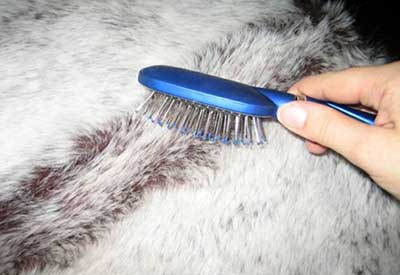
How to wash faux fur at home?
The process is simple. At this time, you can go about your business and not worry about a fur coat or hat. The main thing is to choose the right mode and temperature.
How to wash faux fur at home:
- Use only a liquid product, this is especially good if the furs do not come off. The fur coat must be turned inside out.
- You can soak it in the washing machine. The duration should not exceed 15 minutes. The product can also be soaked in a large basin.
- Turn on the wash cycle. It depends on the type of unit and built-in programs. For faux fur, the “delicate” or “manual” mode is suitable.
- We set the water temperature to no more than 35 degrees.
- The washing duration is the minimum possible. Washing should take approximately 20 minutes. This is followed by rinsing.
- Turn off the spin or set it to minimum speed.
Washed fur must be dried. You should not do this in a washing machine. Drying is carried out under natural conditions.
Sometimes machine washing is not acceptable. To find out whether it is possible or not, read the label on the product.
Also, before the procedure, it is worth assessing the quality and structure of the fur. It is better to clean old fur coats by hand. When machine washed, an old product can become very frayed. the pile may come out, and bald patches will appear, which will be difficult to hide.
Washing denim with patches
Denim items could be monotonous and boring if designers did not come up with embellishments that add uniqueness. Often people are willing to pay for branded jeans embroidered with rhinestones, beads or hand embroidery.
If you have such clothes, they need delicate care.
- use hand wash only;
- the item must be turned inside out so that all decorative elements remain in place;
- You can’t twist such clothes too much; the spin cycle should be gentle. You can even not squeeze at all, but let the water drain on its own;
- sparkling rhinestones from harsh alkaline compounds will fade and the beads will peel off, so use mild detergents;
- take into account the characteristics of the thread from which the embroidery is made. For example, silk thread requires special care;
- For ironing, use mainly steam, also turning the item inside out.
Products used for cleaning fur
In order for the cleaning of fur products to be most effective, it is necessary to use special cleaning products for this. For example, light-colored outerwear can be perfectly cleaned using ordinary purified gasoline. For this purpose, the fur coat or jacket should be shaken well in the air, then gasoline should be applied to the pile with a soft brush, while ironing it according to the growth of the fur.
If, during the above procedures, stains of dirt are found on the fur product, they should be wiped with a cloth along the pile. After you finish cleaning, the product will need to be placed in the open air to remove the smell of gasoline. In addition, such ventilation will allow it to dry faster.
Light-colored outerwear can be perfectly cleaned using ordinary purified gasoline.
If light fur has turned yellow over time, it can be cleaned with a weak solution of hydrogen peroxide. To do this, peroxide (1 tsp) is diluted in 1 glass of warm water. Next, you need to soak a sponge in the prepared solution and use it to clean the contaminated areas, following the direction of the growth of the pile. After this, the fur coat is dried. By the way, experienced housewives advise adding 5-6 drops of ammonia to the described solution.
There is also a recipe for washing a fur coat using ordinary shampoo. To do this, they usually take one that does not contain a balm, with a neutral factor and without color. It is diluted in an amount of 1 tsp. per glass of water. The cleaning procedure itself is similar to that described above.
If you have regular starch on hand, you can also use it to clean the fur. To do this, the powder is generously scattered over the product, and then thoroughly combed out with a soft brush. You can choose a replacement for this product - for example, oatmeal. The main thing is that such a replacement is natural, cleans dirt well, and is easy to apply and remove from the surface of the fur.
If you have regular starch on hand, you can also use it to clean your fur.
Advice!
If your fur coat has long pile, you can clean it with roasted oatmeal.
For this purpose, they are fried in a heated frying pan. After this, the flakes that have not yet cooled down should be scattered over the surface of the fur coat and combed out. Next, it is ventilated in fresh air, shaking occasionally.
Is it possible to wash fur and is it possible to do it yourself without damaging the product? In some cases, yes, if you meet certain conditions. We offer two methods of washing at home.
It is best to wash fur by hand.
Colored and black jeans
The classic color of denim pants is indigo. But black, colored or white jeans look no worse. Black stretch jeans are close to the classic style, while white ones are ideal for the summer season.
Still, such trousers have their drawbacks.
Blacks quickly lose their color. Unlike classic blue ones, this does not decorate them at all, so use special detergents for washing black linen. High water temperatures, spinning, and sun drying also cause the color to fade. Whitish scuff marks may appear on the seams. To avoid this, add a tablespoon of acetic acid when soaking or in the drum. Table salt also has the property of fixing the dye.
White clothes are too dirty and easy to stain. In addition, the color may turn yellow. Despite this, do not use bleach when washing, otherwise stains may appear and the fabric will begin to crumble into fibers. To maintain a white tint, use powder for white items. Soaking in this product will enhance the effect.
How to wash jeans
For hand washing, it is advisable to select products based not only on their cleaning properties, but also on their effect on the skin of the hands:
- Jeans can be washed with regular laundry soap. It cleans fabric well of dirt and copes with complex organic stains on clothes. It is made from natural fats of animal origin, which is important for the skin of the hands.
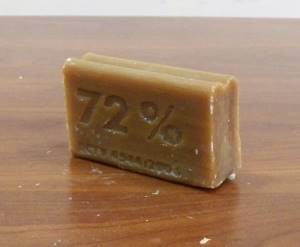
Laundry soap effectively removes dirt during hand washing and cares for the skin of your hands.
- Special laundry detergents made from ingredients of plant origin are safe for health. It’s good if the label contains a mark indicating compliance with SAN PIN standards.

Synergetic is a safe product that can even be used for washing children's clothes.
- It is convenient to clean jeans with a brush. For dense fabrics, a stiffer one is suitable, but for thin and elastic ones, it is better to take a brush with soft bristles. You can use a household sponge.
- If the product has an unstable color, the last rinse should be done in a vinegar solution: 1 tablespoon per liter of water. This will help preserve the color.
Any liquid detergent is suitable for machine washing. They dissolve well in water and are easier to rinse without leaving marks on clothes. You can use special gels for washing denim, which are designed taking into account its characteristics.
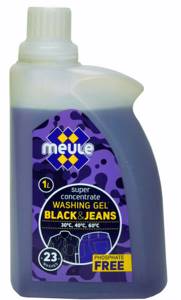
A special product for denim will protect clothes from color loss and make them soft after washing.
When purchasing liquid detergent, focus on color and smell. Open the cap and check that the liquid is white or neutral in color. The brighter it is, the more unnecessary dyes it contains. A pleasant smell is also a sign of excess chemicals. Manufacturers guarantee frosty freshness or the smell of lemon, but this will not affect the quality of the wash.
Table: overview of detergents for denim clothes
| Name | Manufacturer | Release form, volume | Compound | Characteristics of the product | pros | Minuses | Price |
| Bagi Jeans | Bagi, Israel | Gel concentrate, 1 l. |
|
|
| High price | From 320 rubles |
| Domal Jeans | Domal, Germany | Concentrated gel, 750 ml | Does not contain harsh chemicals |
|
| High price | From 408 rubles |
| BiMax Jeans | BiMax, Russia | Concentrated gel, 1.5 l. | Surfactants and dietary supplements |
|
| After the first or second wash, the color change is not noticeable. | From 464 rubles |
| Dreft Black | Dreft, Belgium | Gel, 3 l. |
|
|
| High price | From 754 rubles |
| Luxus professional |
| Gel, 1 l. | Surfactants and phosphates |
|
|
| From 235 rubles |
| Wellery DELICATE Color | New Chemical Technologies LLC, Russia | Gel, 1 l. | Surfactant, does not contain phosphates and dyes |
|
| Not always on sale | From 220 rubles |
| Amway Home SA8 Black | Amway | Gel, 1 l. |
|
|
| High price | From 1300 rubles |
Video: which product removes dirt better
Stretch jeans
Adding synthetic threads to denim has become a necessity. Such fibers increase service life, make the item less susceptible to external influences, and add softness. After tight trousers became fashionable, jeans also began to be made tighter. But the rough fabric still bristled and did not give the desired effect. Therefore, they came up with the idea of adding elastane to jeans so that girls could show off their slender legs in all their glory.
The combination of dense fabric with elastic thread makes stretch jeans indispensable for all occasions, because such clothing hides figure flaws, emphasizing its advantages.
Stretch tolerates washing well, so follow the general rules when cleaning your favorite trousers. And so that over time they do not stretch out on your knees, be especially careful about the spin: it should not be too intense.
Decorative inserts and torn elements
Raw denim that has not been processed is difficult to find in stores today. For the most part, denim clothing comes with synthetic additives to improve the tactile properties of the clothing, its quality, and make it easier to care for. However, only raw denim can acquire unique wear and tear, which only forms during the process of wearing the product. They are individual, just like the lifestyle of the owner of such a thing.
Fashion designers have found a way out. The idea of artificially aging fabric to create scuffs and torn elements has taken root all over the world. These jeans seem to have their own history.
However, we should not forget that the fading created by designers is still a style, and not just torn rags. Therefore, caring for fashionable fringe should be such as to leave all wear and tear unchanged for as long as possible. And the more holes there are in your fashionable jeans, the more carefully you need to clean them:
- hand washing should be a priority;
- In the washing machine, set the delicate cycle at low speed;
- high temperatures are contraindicated, as well as spinning;
- use delicate detergents;
- place the item in a special bag, first turning it inside out;
- Gently straighten before drying.
Fur inserts
A denim jacket with fur inserts looks unusual and stylish.
Natural fur cannot be washed. If it gets wet and uses cleaning products, it will be damaged. So you'll have to go to the dry cleaner.
Faux fur can be washed at home, being careful.
Machine washing is not contraindicated; delicate mode will not spoil the edge. Low temperature, low speed, no machine spin will help preserve the item. The fur should drain and dry on its own in a well-ventilated area, away from heating devices. After drying, use a brush to fluff up the lint.
Automatic wash
Most denim jackets can withstand machine washing. But it is better to reduce the risks to a minimum and carry out the cycle according to all the rules. To avoid mistakes, follow the instructions.
- We fasten all available buttons and locks.
- Turn the product inside out.
- Select the “Jeans” or “Delicate Wash” mode on the washing machine.
- We pour detergent into the main compartment of the tray, and conditioner into the central compartment.
- We adjust the water heating temperature (for light-colored items – 40 degrees, for black and colored items – 30).
- We check that the spin is switched to minimum.
- We turn on an additional rinse to completely rinse the detergent from the fibers.
We suggest you read Why a dishwasher doesn’t dry dishes well.
Then we start the cycle and wait for the program to end. Next, we proceed to drying, which we will discuss in more detail separately.
How to wash denim shoes
Not only clothes are made from jeans. Shoes are no less popular. Usually these are sneakers, ballet shoes, moccasins, slip-ons, which are comfortable to wear in the summer. The undoubted advantages of such shoes are good breathability, the ability to adapt to the foot without external damage, and durability.
Often during production, such shoes are impregnated with special compounds that will better protect them from dirt and water. If there is no such impregnation, use special sprays from time to time to extend the service life.
Machine washable
Shoes are more susceptible to contamination than clothing. For wet care, the rules are the same as for washing clothes, including the choice of temperature.
- Before washing, wash the sole from lumps of earth to avoid clogging the machine.
- It is better to remove removable insoles, especially glued ones. The laces are washed separately.
- Treat heavy stains with stain remover.
- If your machine has a shoe mode, install it.
- It is not recommended to use powder products, as whitish soap stains may remain on the surface.
- Rinse aid should not be used.
Handwash
You can also wash your favorite sneakers by hand.
- Pour warm water into a basin, add detergent, and whip up a little foam.
- Pre-soaking will help remove stains easier.
- Lather the boot and begin cleaning with a soft brush or sponge.
- Rinse your shoes well, preferably under running water.
- To dry, place the sneakers on a cloth vertically, heels down, so that all the water drains away. Spread your tongue and lift it up.
- During drying, ensure good ventilation, away from hot radiators.
- After drying, treat the shoes with a spray to protect them from moisture.
Manually
It is better to wash small items by hand.
A product made of artificial fur fabric with long pile can only be washed by hand, while materials with short pile can easily be machine washed.
If you need to wash a small item, for example, a hat, mittens, collar or hood, proceed as follows. Not very hot water is poured into a container of suitable size, the temperature of which should not exceed 40°C, and liquid soap or gel is added. It is not recommended to use dry washing powders or soaps with active chemical additives, as they can damage the structure of the pile.
Next, the clothes must be soaked for 25-30 minutes, then gently rub the pile with your hands or a soft brush, paying special attention to heavily soiled areas: sleeves, collar, pockets, bottom of the product.
After washing, the fur should be carefully combed
You should rinse your fur item in plenty of water, first warm, then cool. Before squeezing the product, you need to remove it from the water and, placing it on some kind of stand, allow the bulk of the liquid to drain. After this, you need to blot it with a towel several times, without twisting the material in any way.
It is better to dry clothes on hangers, away from radiators. After drying, the fur can be combed with a round-tooth comb.
You should not start washing large bulky items, such as a blanket, if the contamination occupies a small area. It is much easier to remove several stains using a gauze swab dipped in a soap solution.
How to wash fur? Most manufacturers recommend performing this procedure manually. This method is more gentle and suitable for synthetic products.
If you are looking for the answer to the question of how to wash a fur hat, then you should also know - by hand. It is better not to trust such products to automation. If the pompom is not attached well, it may come off. Therefore, it is recommended to handle it by hand.
It is also not recommended to put a fur coat with long pile in the machine.
How to wash faux fur by hand:
- Fill the bathtub with warm water. The temperature of the liquid should not exceed 35 degrees, maximum 40.
- Add detergent and dilute it in water.
- Place the synthetic fur in a container. Press down with your hands or place a weight on top. Make sure the item is completely saturated with water.
- Leave the product to soak for 30 minutes. For faux fur, this time will be enough.
- After soaking, turn the product over to the other side and straighten the pressed pile.
- Then remember the thing with your hands, squeezing the pile into a fist and unclenching it. Do not rub the product, the lint will come out faster.
- Use home remedies or appropriate chemicals to remove stains. The synthetic fiber manufacturer prohibits the use of stain removers, chlorine bleaches, or other chemicals not intended for use on faux fur. They act aggressively on the fiber and quickly damage it.
- Rinse off soap suds in a bathtub with water. Don't use the shower. Strong pressure can cause the pile to come off the base, which has been softened by moisture.
- To completely remove soap, first rinse the product with warm water, then with cold water. This will add shine to the fibers.
- Add a little vinegar in the final rinse. Synthetic fur will smooth out and shine even better.
After finishing washing, all that remains is to dry the product.
We invite you to familiarize yourself with the smell in the refrigerator with the no frost system
How to do this without damaging the synthetic fiber?
Basic rules for drying artificial pile:
- Cannot be placed on the battery.
- Do not hang to dry near a boiler, fireplace or other heating device. The pile may become deformed.
- It is prohibited to use a hair dryer or other means to speed up drying.
- Do not hang in direct sunlight. White fur may turn yellow.
- To dry faster, blot the lint with a clean towel.
- Do not twist or squeeze the product. The pile will begin to come out and, accordingly, thin out.
Follow these rules and enjoy the results. Due to improper handling of faux fur, it may turn yellow, the pile will become shorter (it will break when twisted) and as a result, the fur coat will no longer be as attractive as before.
